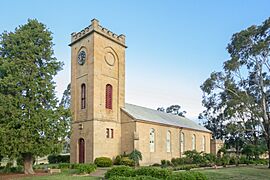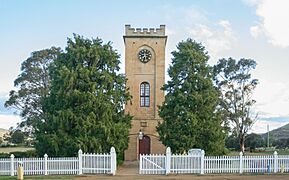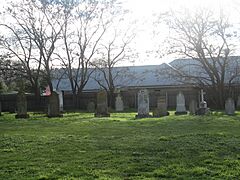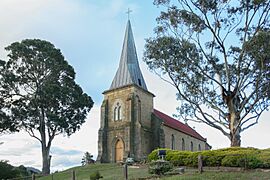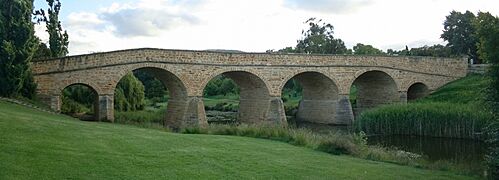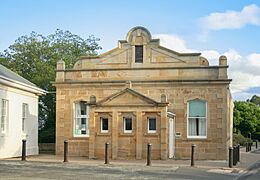Richmond, Tasmania facts for kids
Quick facts for kids RichmondTasmania |
|
|---|---|

Richmond Bridge
|
|
| Population | 880 (2006 census) |
| Postcode(s) | 7025 |
| Location |
|
| LGA(s) | City of Clarence |
| State electorate(s) | Lyons |
| Federal Division(s) | Lyons |
Richmond is a charming town in Tasmania, Australia. It's about 25 kilometers (15 miles) north-east of Hobart, Tasmania's capital city. You can find it in the beautiful Coal River region, located between the Midland Highway and Tasman Highway. In 2006, about 880 people lived in Richmond.
Richmond is famous for its amazing history and old buildings. Many of its sandstone buildings are still standing, looking much like they did a long time ago. This makes Richmond a popular place for tourists to visit.
Richmond's most well-known landmark is the Richmond Bridge. It was built between 1823 and 1825, around the time the town was first settled. This makes it Australia's oldest bridge that people still use today!
The town also has two very old churches. St John's Catholic Church was built in 1836. It is thought to be the oldest Roman Catholic church in Australia. St Luke's Anglican Church was built a little earlier, between 1834 and 1836. It is the oldest Anglican Church in Australia. The clock in St Luke's church tower chimes every hour and is wound by volunteers.
Richmond used to be an important stop on the road between Hobart and Port Arthur. But in 1872, the Sorell Causeway was built, creating a new route.
Contents
A Glimpse into Richmond's Past
Richmond started as a small settlement in the early days of the Van Diemen's Land penal colony. This was a time when Australia was a place where convicts were sent from Britain. Later, Richmond became a police district. This meant it was a center for law and order in the area.
In the 1820s, Governor George Arthur wanted to make sure convicts followed the rules. He appointed special magistrates to oversee them. This helped Richmond grow as a local government center. It held court hearings and council meetings for the surrounding areas.
Building with Convict Labor
Many of Richmond's famous buildings were built by groups of convicts called 'Chain Gangs'. These prisoners worked on construction projects near the town. For example, the Grass Tree Hill Road and Governor Arthur's Road, which lead into Richmond, were built by convicts between 1833 and 1838.
Sometimes, these workers didn't have enough food or clothing. This led to some problems, like stealing. If prisoners were caught stealing or setting traps for kangaroos to get food, they were punished. Despite these challenges, these convict gangs built many of the beautiful Georgian-style buildings you see in Richmond today. This includes the famous Richmond Bridge, the Court House, and the Gaol.
Early Days of the Town
The area was first known as the Coal River district. Lieutenant-Governor William Sorell was one of the first people to help plan a town here. Land for the town was officially surveyed in the mid-1820s.
By 1832, a visitor named James Backhouse reported that Richmond had a court house, a gaol (jail), a windmill, and about thirty houses. When he visited again in 1834, the town had almost doubled in size! The court house was built in 1825-1826, and part of the gaol in 1825. The Richmond Post Office opened on June 1, 1832.
The foundation stone for St Luke's Church was laid on February 3, 1834, by Governor Arthur. It is considered one of the best churches designed by the architect John Lee Archer.
Coal was discovered near the Coal River in 1803 by James Meehan. It was even mined there as early as 1805. A small underground coal mine, the Lowland Coal Mine, operated briefly from 1840 to 1842.
Fun Things to Do in Richmond
Richmond is a fantastic place to visit, with lots of interesting tourist attractions. Here are some of the highlights:
- Richmond Bridge: Don't miss Australia's oldest bridge still in use!
- Richmond Gaol: Explore this historic jail and learn about its past.
- Richmond Court House: Another old building with a lot of history.
- Zoodoo Wildlife Park: Get up close with amazing animals.
- Old Hobart Town: See a cool model of what Hobart looked like in the 1800s.
- Many old and heritage-listed buildings and parks: Just walking around Richmond is like stepping back in time!
Images for kids



